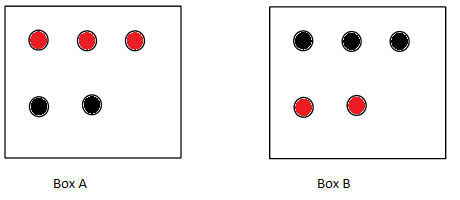
Box $A$ contains $3$ red and $2$ black balls. Box $B$ contains $2$ red and $3$ black balls. One ball is drawn at random from box $A$ and placed in box $B$. Then one ball is drawn at random from the box $B$ and placed in $A$. The probability that the composition of balls in the two boxes remains unaltered is
A: $\dfrac{9}{{30}}$
B: $\dfrac{4}{{15}}$
C: $\dfrac{{17}}{{30}}$
D: $\dfrac{{16}}{{30}}$
Answer
553.8k+ views
Hint: First, consider the red ball is transferred from box $A$ to box $B$ and then consider black ball is transferred from box $A$ to box $B$. Consider the same with respect to box $B$. Then find the probability of all to arrive at the required answer.
Complete step-by-step answer:
Below diagram shows the two boxes which contain red and black balls.

First, we take some cases to find the probability.
Case A: here, let the red ball be transferred from box $A$ to box $B$.
Case B: Here, the black ball is transferred from box $A$ to box $B$.
Case C: here, the red ball is transferred from box $B$ to box $A$.
Case D: here, the black ball is transferred from box $B$ to box $A$.
Now, we will find the probability of the above cases.
By using the probability formula, given below we find the required probability.
$P(A) = \dfrac{{n(A)}}{n}$
Where $P(A)$ denotes the probability of A
$n(A)$ is the number of occurrences of A or the number of favorable outcomes.
$n$ is the total number of possible outcomes or the sample space.
Now, in box A we have $3$ red balls out of $5$ balls so probability can be written as $P(A) = \dfrac{3}{5}$
And we have $2$ black balls in box A so this can be written as $P(B) = \dfrac{2}{5}$ .
After transferring balls from box A to box B we can write as below,
$P\left( {\dfrac{C}{A}} \right) = \dfrac{3}{6}$ and $P\left( {\dfrac{D}{B}} \right) = \dfrac{4}{6}$
Now, to find the probability of composition of balls that remains unaltered are
$P = P(A) \times P\left( {\dfrac{C}{A}} \right) + P(B) \times P\left( {\dfrac{D}{B}} \right)$
$ = \dfrac{3}{5} \times \dfrac{3}{6} + \dfrac{2}{5} \times \dfrac{4}{6}$
Taking L.C.M, we get
$ = \dfrac{{9 + 8}}{{30}}$
$ = \dfrac{{17}}{{30}}$
The probability of composition of balls that remains unaltered is $\dfrac{{17}}{{30}}$. Therefore, the option C is correct.
Note: In probability questions one thing you need to learn is observation and analysation. When taking the sample space and the number of favorable outcomes we should take care that we are taking the correct value otherwise it will lead to the wrong answer.
Complete step-by-step answer:
Below diagram shows the two boxes which contain red and black balls.

First, we take some cases to find the probability.
Case A: here, let the red ball be transferred from box $A$ to box $B$.
Case B: Here, the black ball is transferred from box $A$ to box $B$.
Case C: here, the red ball is transferred from box $B$ to box $A$.
Case D: here, the black ball is transferred from box $B$ to box $A$.
Now, we will find the probability of the above cases.
By using the probability formula, given below we find the required probability.
$P(A) = \dfrac{{n(A)}}{n}$
Where $P(A)$ denotes the probability of A
$n(A)$ is the number of occurrences of A or the number of favorable outcomes.
$n$ is the total number of possible outcomes or the sample space.
Now, in box A we have $3$ red balls out of $5$ balls so probability can be written as $P(A) = \dfrac{3}{5}$
And we have $2$ black balls in box A so this can be written as $P(B) = \dfrac{2}{5}$ .
After transferring balls from box A to box B we can write as below,
$P\left( {\dfrac{C}{A}} \right) = \dfrac{3}{6}$ and $P\left( {\dfrac{D}{B}} \right) = \dfrac{4}{6}$
Now, to find the probability of composition of balls that remains unaltered are
$P = P(A) \times P\left( {\dfrac{C}{A}} \right) + P(B) \times P\left( {\dfrac{D}{B}} \right)$
$ = \dfrac{3}{5} \times \dfrac{3}{6} + \dfrac{2}{5} \times \dfrac{4}{6}$
Taking L.C.M, we get
$ = \dfrac{{9 + 8}}{{30}}$
$ = \dfrac{{17}}{{30}}$
The probability of composition of balls that remains unaltered is $\dfrac{{17}}{{30}}$. Therefore, the option C is correct.
Note: In probability questions one thing you need to learn is observation and analysation. When taking the sample space and the number of favorable outcomes we should take care that we are taking the correct value otherwise it will lead to the wrong answer.
Recently Updated Pages
A man running at a speed 5 ms is viewed in the side class 12 physics CBSE

The number of solutions in x in 02pi for which sqrt class 12 maths CBSE

State and explain Hardy Weinbergs Principle class 12 biology CBSE

Write any two methods of preparation of phenol Give class 12 chemistry CBSE

Which of the following statements is wrong a Amnion class 12 biology CBSE

Differentiate between action potential and resting class 12 biology CBSE

Trending doubts
What are the major means of transport Explain each class 12 social science CBSE

Which are the Top 10 Largest Countries of the World?

Draw a labelled sketch of the human eye class 12 physics CBSE

Explain sex determination in humans with line diag class 12 biology CBSE

Explain sex determination in humans with the help of class 12 biology CBSE

Differentiate between homogeneous and heterogeneous class 12 chemistry CBSE




